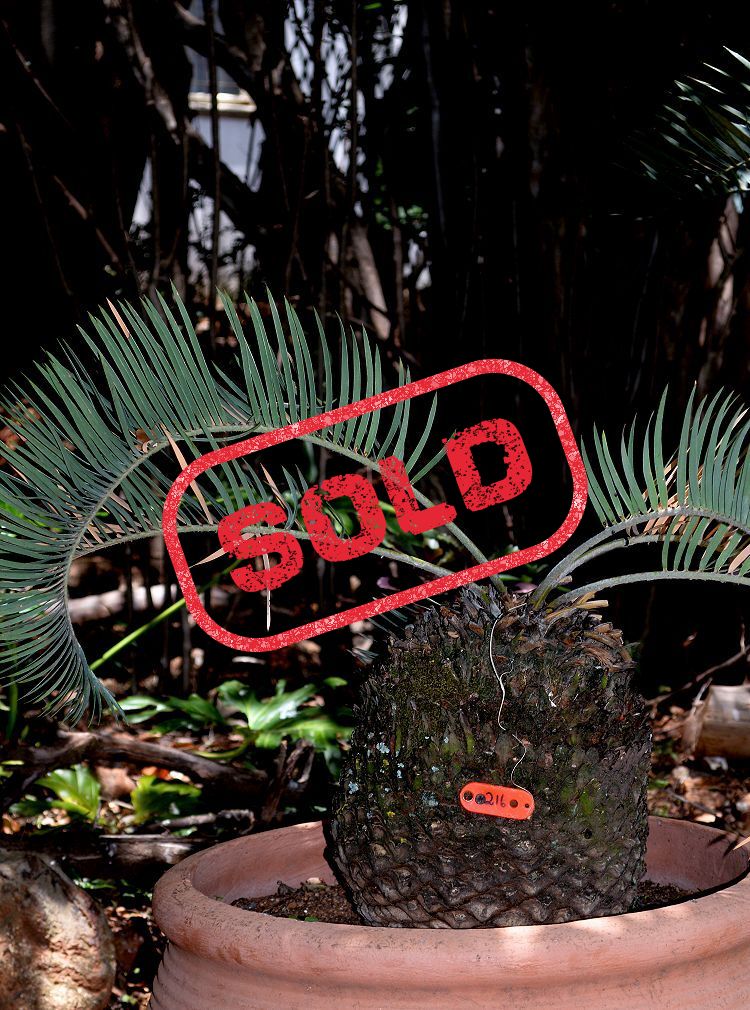|
| Division: Cycadophyta |
| Class: Cycadopsida |
| Order: Cycadales |
| Family: Zamiaceae |
| Genus: Encephalartos |
| Species: E. lanatus |
Conservation Status: |

E. lanatus
Olifants River CycadEncephalartos lanatus, also known as the Olifants River Cycad or the Woolly Cycad, occurs in the upper catchment area of the Olifants River in the Middelburg, Witbank and Bronkhorstspruit districts of the Gauteng and Mpumalanga provinces in South Africa. It also occurs along the Little Olifants and Wilge rivers in this area. It is normally a medium-sized, single-stemmed plant about 1–1,5 m high. In the garden, it enjoys a position in full sun and is a strong architectural plant that makes a good focal point. E. lanatus is frost-hardy, fire-adapted and drought-resistant.
It is a small, slow-growing tree with stems usually about 1,5 -2,5m long and 25–30 cm in diameter. The young leaves are grey and woolly and have a curved apex. Mature leaves are greyish green, about 60–80 cm in length.
Both male and female cones are densely woolly when young, and become yellow with age. They are dioecious, i.e. the cones are borne on separate plants. Female cones are barrel-shaped, 25–30 cm long and 12–15 mm in diameter. Male cones are cylindrical, 25–30 cm long and 5–6 cm in diameter. E. lanatus sometimes sends out suckers at the base of the main stem. The mature seeds are yellow and fleshy and smaller than those of other commonly cultivated species such as E. altensteinii.
Cultivation:
E. lanatus is easily grown from seed. Hand pollination is necessary for a successful seed harvest in cultivation. Pollen can be collected as soon as it starts shedding. If a slight tapping of the male cone sheds pollen, then the cone is ready to be harvested. Pollen should be stored at – 15°C for best results. The female cone scales have to be monitored to check if they are open. The window of the scale opening varies with plants, from three days to two weeks. The wet method using distilled water in a syringe could give a good pollination rate. After female cones have been collected the seed is left to mature for a year before sowing at the beginning of summer.
For best results, seed is sown in river sand on a heated bench at 24–28°C. Germination should start after three weeks after sowing. However, some seeds will take longer.
E. lanatus is slow-growing and reported to be very difficult to transplant; plants die easily or take a long time to recover when transplanted. Leaves and cones are prone to scale and mealybugs.
| full sun | blue-green | low watering | slow growth | frost-hardy | common |
E. lanatus is easily grown from seed. Hand pollination is necessary for a successful seed harvest in cultivation. Pollen can be collected as soon as it starts shedding. If a slight tapping of the male cone sheds pollen, then the cone is ready to be harvested. Pollen should be stored at – 15°C for best results. The female cone scales have to be monitored to check if they are open. The window of the scale opening varies with plants, from three days to two weeks. The wet method using distilled water in a syringe could give a good pollination rate. After female cones have been collected the seed is left to mature for a year before sowing at the beginning of summer.
For best results, seed is sown in river sand on a heated bench at 24–28°C. Germination should start after three weeks after sowing. However, some seeds will take longer.
E. lanatus is slow-growing and reported to be very difficult to transplant; plants die easily or take a long time to recover when transplanted. Leaves and cones are prone to scale and mealybugs.
E. lanatus for sale at AfricaCycads.com:
|

